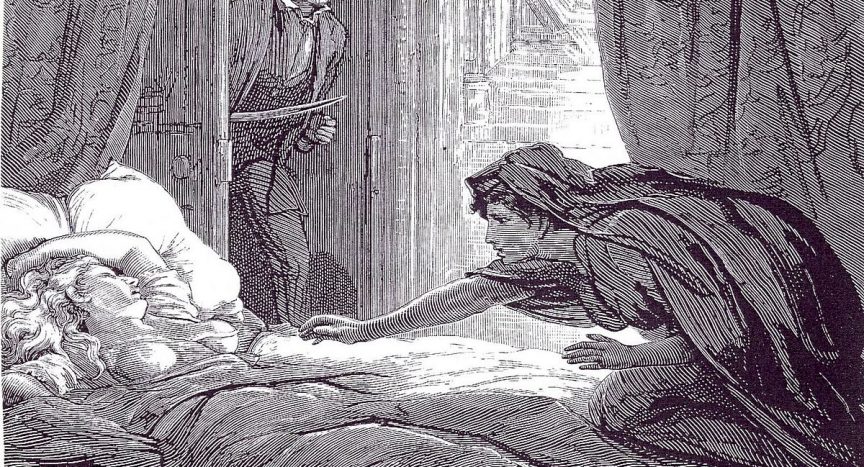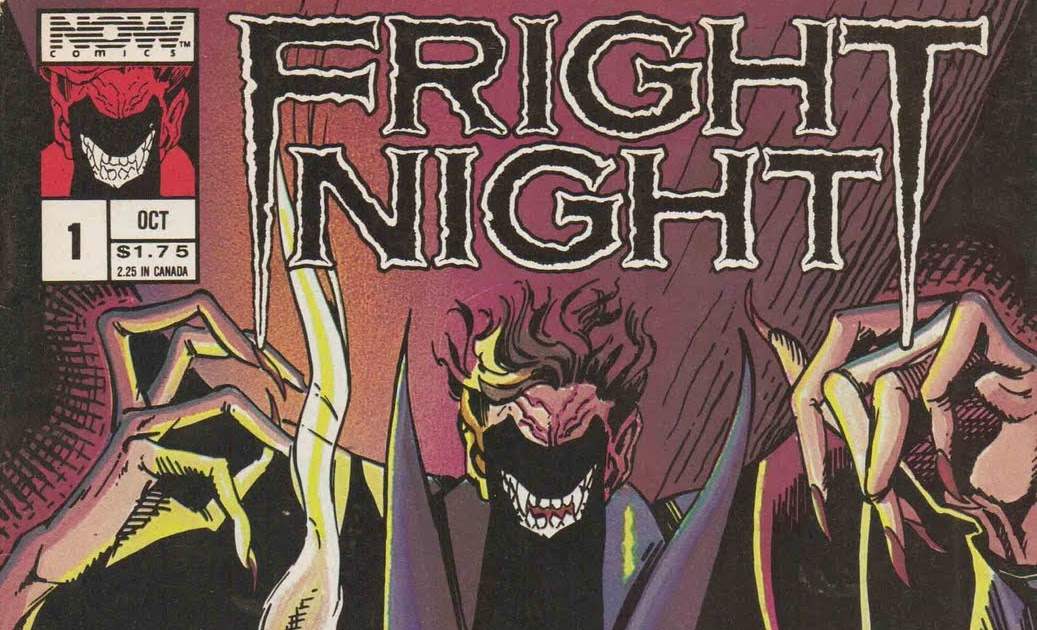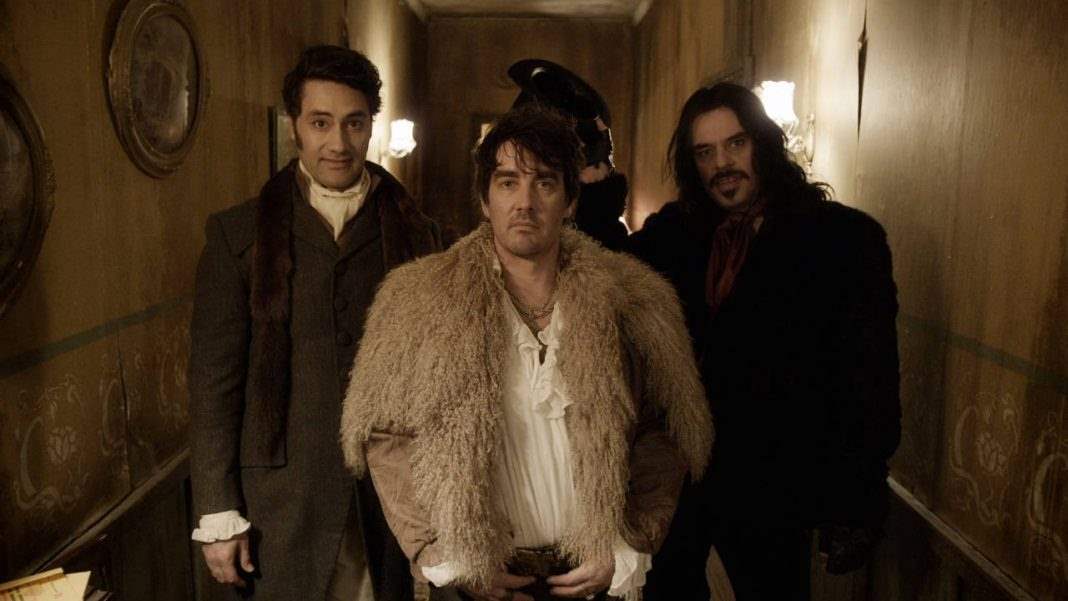Dracula was an obsessively well-researched book. While the novel was published in 1897, Stoker had written his first notes on the story—of a young solicitor unknowingly venturing into the home of a vampire—at the beginning of the decade. He researched history, learned the names of Transylvanian locations like Bistritz and the Borgo Pass, studied the path of the Carpathian Mountains as best as he could and, most importantly, read virtually every vampire story that had published up to that point. John Polidori’s “The Vampyre” (lifted heavily from Lord Byron’s “Fragment of a Novel”) certainly had an influence on the aristocratic Count, although the story’s Lord Ruthven, somewhat ironically, more resembles the Dracula of the film adaptations than Stoker’s novel itself. Varney the Vampire was a serial of pure pulp, but the central woman being bitten by a vampire and turning into one herself very much inspired the novel’s middle section and Lucy’s transformation into a vampire. But no story inspired Dracula more than J. Sheridan Le Fanu’s Gothic novella, Carmilla.
The novella depicts a young woman named Laura, almost a fairy tale heroine, living in a beautiful castle in a sun-lit forest, who has the whole world before her, but is terribly lonely and only wants—more than anything—a friend. And that’s very much how Carmilla plays out at first: like a fairy tale. A carriage accident brings beautiful, but sickly Carmilla to her doorstep and the two become fast friends. Carmilla is strange, enchanting, but tells Laura nothing of her past and that only makes Laura that much more curious about her. As Carmilla’s health improves, everyone else seems to become sick around her, and despite how much she cares for her new companion, Laura must come to terms with the truth about what Carmilla is.
Stoker was so inspired by Carmilla, in fact, that he originally intended to set the novel in Styria, where Le Fanu’s novella is set. The story contains many overt similarities with Dracula, things that certainly offered much inspiration, such as a young woman being preyed upon by a vampire, vampirism depicted as a slow illness that seems to drain a person before ultimately killing them, and an expert on the subject who comes in and provides necessary exposition before ultimately dispatching the undead. Both Dracula and Carmilla pass off their own backstories as those of an “ancestor.” Carmilla, in appearance, with her languid features, her pale skin and dark hair, closely resembles Lucy Westenra, who of course becomes Dracula’s most prominent female vampire.
See Also: Script to Pieces: Hammer Films’ Vampirella

These connections make Carmilla that much more fascinating, historically, because they showcase a fundamental influence on what is inarguably one of the most famous stories ever told and one of the most prominent characters in the entire pantheon of pop culture. But they’re also somewhat bittersweet at the same time, as they draw focus away from Carmilla as a story and make it difficult to read and appreciate the novella on its own merits. Because there are plenty. In fact, I would not hesitate at all to call Carmilla one of the best vampire stories ever written.
Of course, Carmilla can be and often is discussed separately from Dracula, in a larger context that is perhaps even more well known than its influence on Bram Stoker. I’m talking, naturally, about what is often referred to as the story’s lesbian subtext. I take issue with that terminology for one reason and one reason only: if the genuine, non-platonic love between Carmilla and Laura is subtextual, then Carmilla has no plot. It’s not the subtext of the story. It is the story, and it’s as overt as gothic literature in the 1870s could possibly be. It’s felt in every interaction between the two of them, every time Laura remarks about Carmilla’s beauty without adding “I wish I looked like that,” and is made explicitly clear when Laura asks Carmilla if she has ever been in love and Carmilla answers her, “I have been in love with no one, and never shall, unless it should be with you.” That’s the heart of the story, as well as the source of its melodrama and conflict as we know that Carmilla is a vampire and that this romance is ultimately doomed. There’s such a sense of melancholy to Carmilla, and rather than wallowing in that sadness, the story revels in it. Carmilla isn’t attractive despite her dreariness. The dreariness is the attraction.
The attraction between Laura and Carmilla is immediate, though Laura instantly notices that there is something strange and ethereal about the girl. And it’s in the love story that makes up the core of the novella that it ultimately breaks from the traditions of the past. These days, people are quick to point out that the Old World vampires of folklore were much more overtly monstrous, less romanticized by far than the vampires we see in pop culture today. And if that’s true now, it’s far more true for 1872, when Carmilla was written. In fact, at that point in time, it wasn’t simply a matter of subverting the conventions of vampire stories—of which there were barely any, at least in the English language. It was bigger than that, because this was a time when much of the world still believed in vampires. In fact, parts of Europe were seeing a resurgence of vampire panic while in New England it was being treated as a full-blown epidemic. In the winter of 1816, after Samuel Salladay moved his family from Switzerland to Ohio, they began to die from Hereditary Consumption, one by one. After Salladay died, his son died from the same illness and believing this to be the work of a vampire, they dug Salladay up and burned his entrails in the fireplace to stop the spread of the disease, to no avail. In 1817, Frederic Ransom of Vermont was also exhumed under the belief that he had returned from his grave as a vampire.
Also See: Six Vampire Novels That Went Widely Overlooked
 That’s a very different thing than the sympathetic portrayals of Barnabus Collins, Lestat, or Angel (all of whom Carmilla clearly influenced to some degree) because Carmilla was written at a time when there were people who still believed vampires to be a very real and serious threat. Of course, at the same time, that belief was not commonplace. Those stories of vampire exhumations and stakings became so highly publicized because they were not, by any means, the norm. Yet even still, they were much more common than they’ve certainly been since, and enough people had to keep believing in those superstitions for those things to keep happening in the so-called “New World.” Nonetheless, Carmilla reflects an era when vampirism was very much defined by illness.
That’s a very different thing than the sympathetic portrayals of Barnabus Collins, Lestat, or Angel (all of whom Carmilla clearly influenced to some degree) because Carmilla was written at a time when there were people who still believed vampires to be a very real and serious threat. Of course, at the same time, that belief was not commonplace. Those stories of vampire exhumations and stakings became so highly publicized because they were not, by any means, the norm. Yet even still, they were much more common than they’ve certainly been since, and enough people had to keep believing in those superstitions for those things to keep happening in the so-called “New World.” Nonetheless, Carmilla reflects an era when vampirism was very much defined by illness.
In general, the story’s approach to illness is fascinating. Not only is Carmilla herself something of a plague carrier, but she is also—already being a vampire—feigning illness from the first moment we’re introduced to her. For a lot of people, this makes the relationship between Carmilla and Laura harder to invest in, as not only is Carmilla lying about being a vampire, she’s also something of a grifter. On that level, she could be seen as no better than Willy Wonka’s Grandpa Joe, lying in bed without lifting a finger to help his struggling family, then revealing he’s been in fine health the whole time when the opportunity to tour a candy factory comes along.
I think that interpretation really misses the point of the story as a whole and the tragedy of Carmilla as a character, though. Reading into her interactions with Laura, there’s an important scene in which Laura asks Carmilla if she’s ever been sick before, and it’s as close as the vampire ever comes to outright telling the truth. She says she was sick once, a very long time ago, and when it’s suggested to bring in a doctor, Carmilla very pointedly says “Doctors never did me any good.” It’s a revealing line, but more than that it’s a very sad line, as she obviously reflects on her own death and proves—for a brief moment—to be nostalgic for her life, no matter her actions. There’s an observed sadness to everything Carmilla does when she is pretending to be ill, and that’s literally because she’s essentially re-enacting her own death. As such, it’s not as harmful as it is made out to be, because it is based entirely in memory, not manipulation.
 Another constant theme in Carmilla is that of destiny. Laura dreamed of Carmilla when she was a little girl, and Carmilla claimed to dream of her as well. There’s a repeated line in Shirley Jackson’s The Haunting of Hill House that says, “Journeys end in lovers meeting.” That is certainly true of Carmilla, in some respects. Laura’s story for those first few pages is that of a girl who has never known a friend or a lover and finally, fatefully, finds both on her doorstep. However Carmilla orchestrated their meeting, it is perceived by both to be fate. And as such, it is completely romanticized, particularly when Carmilla says to Laura, “You are mine, you shall be mine, you and I are one forever.” It should be interpreted as threatening, knowing that one is a vampire, and it is certainly an unhealthy and possessive thing to say, but in the text it completely reads as romantic, not malicious. Carmilla herself even recognizes that selfishness, but again explicitly states the nature of their relationship by telling Laura that love is always selfish. This also marks perhaps the best example of the story’s subversion of folklore, as even though the plot ultimately treats Carmilla as a monster, the story characterizes her as a fully-formed, fleshed out character. It humanizes her, even more than Stoker would ultimately do with Count Dracula.
Another constant theme in Carmilla is that of destiny. Laura dreamed of Carmilla when she was a little girl, and Carmilla claimed to dream of her as well. There’s a repeated line in Shirley Jackson’s The Haunting of Hill House that says, “Journeys end in lovers meeting.” That is certainly true of Carmilla, in some respects. Laura’s story for those first few pages is that of a girl who has never known a friend or a lover and finally, fatefully, finds both on her doorstep. However Carmilla orchestrated their meeting, it is perceived by both to be fate. And as such, it is completely romanticized, particularly when Carmilla says to Laura, “You are mine, you shall be mine, you and I are one forever.” It should be interpreted as threatening, knowing that one is a vampire, and it is certainly an unhealthy and possessive thing to say, but in the text it completely reads as romantic, not malicious. Carmilla herself even recognizes that selfishness, but again explicitly states the nature of their relationship by telling Laura that love is always selfish. This also marks perhaps the best example of the story’s subversion of folklore, as even though the plot ultimately treats Carmilla as a monster, the story characterizes her as a fully-formed, fleshed out character. It humanizes her, even more than Stoker would ultimately do with Count Dracula.
After all, even when he is open and kind with Harker after they first meet, everything Dracula does is manipulative. It’s all a calculated act of evil. After Lucy succumbs to illness and becomes a vampire, she is monstrous. She might as well be an animal. She ceases to be humanized and becomes a thing. That is hardly the case with Carmilla, who is humanized throughout the entire text, perhaps even more so than Le Fanu intended. After all, despite the subversion of folklore by humanizing the vampire, making her a central character and giving her a genuine love story, the novella still ends like any vampire story of the era. More than that, it reflects the folklore of the time completely despite otherwise subverting it throughout the text, with Carmilla being dragged out of her tomb looking exactly like those descriptions of believed vampires being excavated from their graves: rosy-cheeked, vibrant as though they were still alive, with blood around their mouth.
With that in mind, it must certainly be noted that Carmilla is far from perfect. It is unquestionably of its time. Given its central love story that ends in Carmilla’s staking, it’s got to be one of the earliest instances of the unfortunately persistent dead lesbian trope. As sincere as the love between Carmilla and Laura might be, it is obviously not without manipulation. Nonetheless, it remains one of the most important vampire stories ever told. It is a personal favorite, I’ll admit. Carmilla drips mood and atmosphere, but romanticizes the dark and the dreary in a way that most vampire stories—depicting things as outright tales of horror—rarely did at the time. It feels more modern than even Stoker’s novel, despite featuring barely any “modern” elements at all. The story itself barely feels contemporary to 1872 and could easily take place a hundred years before. Its influence on Dracula might remain the story’s greatest legacy, but even taken on its own, it is one of most unique, heartfelt and altogether important vampire tales ever told.







